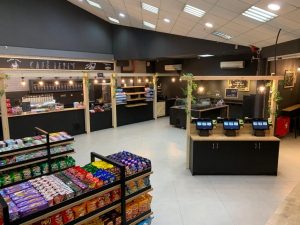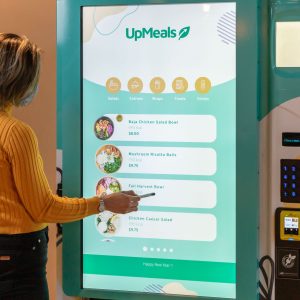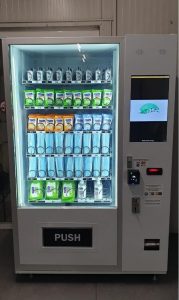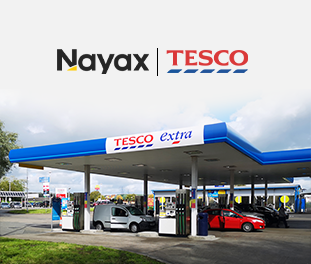Editor’s Note: This article was originally published in May 2021 and has been updated for accuracy.
The Ultimate Guide to Mastering the Micro Market Vending Industry
Micro markets are one of the fastest-growing trends in the foodservice and retail industries. Pushing the boundaries of what unattended technology can offer, micro markets are bringing in unparalleled levels of convenience to millennial and Gen-Z users who are always on the go.
Before we dig deeper into the new opportunities and future potential of this burgeoning industry, let’s first understand the evolution of micro markets and their appeal for both consumers and retailers.
Explained: The Past, Present, and Future of Micro Markets
What Are Micro Markets?
Micro markets are self-service convenient stores that go one step beyond the traditional vending machine model. Sitting at the intersection of the labor-saving point of sale (POS) and self-service dining and retail, micro markets ditch closed kiosks in favor of temperature-controlled open shelves, reach-in coolers, and glass door freezers.
Consumers are free to pick up freshly prepared food and beverage products, review them for nutrition information and other details, and checkout with an easy-to-use micro market kiosk. Micro market vending most often uses cashless payment solutions such as credit or debit cards, NFC mobile payments, or prepaid cards, especially in closed-loop environments such as the workplace. Closed-loop environments such as offices, multi-family residential complexes, and universities are ideal for micro market vending because it relies on a system of honesty in which consumers are expected to pay for their own purchases without human intervention or supervision.
Customers often describe micro markets as 24/7 convenience stores at their office or apartment building, where they can access and purchase healthy snack and beverage options around the clock.
By combining flexibility with variety and efficiency, micro market vending has brought explosive growth potential to the vending industry. By replacing drab and boxy vending machines with strategically placed snacks, meals, and refreshments in an open layout, micro markets have become artistic places where employees crave to spend their break time.
Ask us about our micro market solutions
The Shift Towards Healthy Food Vending Makes Micro Market Vending More Attractive
Micro markets have largely emerged in response to the increased demand for healthy and fresh food options. More and more consumers today are gravitating toward healthy eating and are trying everything from eating smaller portion sizes with each meal to cutting back on fast food.
In March 2023, the World Economic Forum found that 50% of Americans actively try to eat more healthy food. And let’s not forget that there is a direct correlation between healthy eating habits and higher productivity at the workplace.
This is why forward-thinking organizations and multi-brand workplaces that are open at odd hours or operate in a shift-based system are embracing fresh micro markets as an essential feature of the modern office.
Giving people healthy, grab-and-go style meal options on the job comes with multiple benefits. Adopting micro market vending at the office not only helps employees meet their healthy-eating goals, but this simple act also makes the workspace more cohesive. It gives a clear, recognizable, competitive edge to the employer. And though providing fresh food options can be more of a challenge than snacks that can last a couple of weeks, with the proper management tools, you’ll be able to stay on top of your inventory, expiration dates, and stock levels.
Micro Market Kiosks and the Convenience of Cashless Self-Checkout
One of the biggest allures of micro market vending is the seamless self-checkout experience it provides to consumers. Consumers use cashless payment methods to pay for goods at micro markets, allowing for a quicker checkout process. With the growing popularity of contactless payments such as EMV chip cards and mobile wallets, the process is as easy as pick-scan-pay. And since most micro markets are located in closed-loop environments, many people pay with employee or student prepaid cards which can be either physical cards, fobs, or even digitalized.
Furthermore, several large corporations with micro markets on their premises provide a preorder and prepay service for their staff. In this system, employees can access the daily menu options through a customized mobile app, and order and purchase different meals quickly and conveniently through their mobile devices.
Get started with Nayax micro markets
Where to Place Your Micro Market Vending Business
When micro markets began to emerge, the general perception was that the best placement opportunities would be in locations where populations were between 150 and 500. It was believed that locations with populations under 150 may not be profitable enough, while for larger populations, on-site dining or cafeteria services may be more effective.
But that was then. Today, industry experts have lowered the minimum threshold number to 50, and in some cases, even less – depending on the number of hours being spent on-site and whether or not there are other 24/7 dining options available in the area.
As a whole, most micro market vending businesses are located at large manufacturing facilities followed by offices, retail sites, hospitals, schools, military bases, and hotels.
Now, all these locations have also been popular spots for traditional vending machines. But operators in the industry say that compared to conventional vending, they have experienced higher revenue growth with their micro markets. Operators report that they get 18% more visits a week and make 1.2 sales per day per visit (versus 0.7 at vending locations). This means that the average micro market operator can make $1,000 per week in revenue at larger locations (of 125 and more potential customers).
Micro Market Vending Revenue and ROI
Micro markets are major growth multipliers. According to experts, the average profit made with the old-school vending model is 1.15%. A micro market, meanwhile, returns 17% in profits.
This is because of two reasons:
- The upfront investment in micro markets is considerably lower than for a traditional vending bank (nearly $14,000 lower)
- Operators can offer more varied products at a higher price and to increase average transaction value.
Customers are also more likely to buy multiple products at a micro market than they are at a vending machine because of the varied product offerings and the fact that they can do so seamlessly with one transaction.
How to Choose the Right Micro Market Vending Display
A micro market is typically divided into four distinct zones: hot and cold beverages, fresh meals, snacks and candy, and impulse buy items. Access to a power supply is essential for coolers and micro market kiosks.
Broadly, in a micro market environment, operators desire easy-to-install fixtures that they can move or even add to in case of future expansion. As such, free-standing display units are the most sought-after. These units can easily be placed anywhere and do not require an operator to drill into a wall.
Lightweight, durable, and portable are the keywords here. So, using free-standing baskets and easily movable spinning racks can also be an option to give the market a fresh look.
And since one of the most important aspects of merchandising is having an appealing aesthetic, depending on your micro market’s location it’s a good idea to add internal lighting to the displays and highlight the products. A high-end look can also be brought in by using professional signage and ensuring that different colored products are grouped and placed effectively.
To catch the customer’s attention, new products should always be placed at eye level. If two products are a part of a promotional campaign – such as a breakfast sandwich and coffee combo – they must be within reach of each other.
And of course, impulse buy items such as candy and gum should be as close to the micro market kiosk as possible, so that customers can just grab them, scan them, and pay before they have a chance to second guess themselves.
Best-Selling Micro Market Products
While a traditional vending machine has the capacity to hold about 40 different products, an average micro market can easily stock anywhere between 150 and 400 products.
According to a Vending Market Watch report, cold beverages, snacks, and candy are the largest revenue-generating categories in micro market vending. When different categories of consumers were queried about their snacking preferences in a re recent survey, ‘wanting to eat healthier while snacking’ and ‘eating on the go’ emerged as major themes.
While Boomers and Gen-X go to micro markets for healthy, low-fat, sugar-free, or reduced-sodium snacks, Millennials typically seek out fresh micro markets for a complete afternoon meal.
Interestingly, non-food items also sell well in micro markets. Electronics (cell phone chargers), toiletries, and health and wellness products, such as antacids and aspirin, have been known to be popular among consumers.
Experts recommend introducing new, seasonal, and trendy products frequently to ensure that the market doesn’t feel stale. Since micro markets can offer a much wider number of stock-keeping units (SKUs) compared to traditional vending machines, it’s prudent that operators have an open dialogue with customers and understand their demands and desires.
Product diversification is one of the top trends impacting the success of micro markets today.
Vending Management Systems for Micro Markets

To manage inventory effectively and to maximize profits and performance, operators like to integrate their systems with a vending management system.
Vending management systems and vending management apps provide deep insights into vending operations and allow micro market operators to manage their business remotely and on the go. With a vending management app, operators can receive push notifications warning them of adverse events that need to be resolved right away, such as a micro market kiosk getting unplugged, which allows them to preempt operational malfunctions and prevent revenue loss.
Apart from the obvious emergency situations for which operators need a vending management system, these systems also help operators manage inventory, keep track of stock levels, and restock their micro markets more efficiently. This also benefits the end customer, as operators can create reports that show them which products are the most and the least popular, helping them gain insight into consumer behavior and give their customers more of what they want.
Ask us about our vending management solutions
Micro Market Vending Customer Loyalty Programs
An Oracle study has found that increasing customer retention by just 5 percent can improve profits by as much as 95 percent. This is because loyal customers spend an average of 67 percent more on each transaction and also increase their visit frequency by 35 percent. As such, an engaging loyalty program can be instrumental in the growth of a micro market.
Better yet, capitalizing on the popularity of a loyalty reward program in closed environments is not difficult.
Through a vending telemetry solution, organizations can establish different price points for different payment methods and offer discounts to their employees if they pay via company prepaid cards. Discounts can also be set up for specific products, based on an analysis of best- and worst-selling products.
Offering different loyalty membership types can be another way of introducing loyalty rewards in a micro market. Each membership level could be customized to offer varying benefits and users can then be encouraged to spend more to achieve a higher status.
A micro market operator may also consider a credit card reader app that would seamlessly integrate with digital wallets and reward regular customers with loyalty discounts, daily specials, and other benefits.
Micro Markets in the Post-COVID-19 Era
In a world where food safety and sanitization protocols became more stringent overnight, micro market operators soon discovered that they were uniquely poised to be efficient last-mile suppliers in many communities. As the COVID-19 pandemic swept across the world, many micro markets began to (and continue to) stock face masks, hand sanitizers, and other personal protective equipment.
Operators took advantage of micro markets’ open concept and robust cashless payment systems to boost physical distancing and minimize the need for customers to touch the same surfaces as everyone else.
Now, though the COVID-19 pandemic is less of a concern for the masses, many of the habits picked up during the outbreak have stuck. A significant shift towards cashless payments accompanied by a growing demand for quicker and more convenient service have set the stage for micro markets to take over.
Major Growth for Micro Market Vending is Imminent
From an estimated market size of $134 billion in 2020, the global vending machine industry is expected to reach $146 billion by 2027. Micro markets will play a major role in this growth.
Statistics show that between 2012 and 2020, the micro market vending industry has almost doubled in size. As of 2020, there are more than 30,000 micro market locations globally, bringing in more than $7 billion in sales. Industry analysts are convinced that in the next 5 years, another 30,000 micro markets will be launched.
The record growth in micro market kiosks can be attributed partly the shift in consumer behavior since the outbreak of COVID-19. Micro market vending eradicates the need for a customer to physically interact with grocery store employees or other shoppers. There is also no need to exchange ‘dirty’ paper currency. As such, people can shop locally, even as they maintain social distancing guidelines.
And let’s not forget that many organizations are now giving employees the option to either work remotely or are introducing a hybrid working model where an employee would not be required to report to the office every day. With fewer people on-site, conventional catering options make less financial sense for most firms. Employees also prefer hygienically-packed grab-and-go food items compared to fully-exposed meals in cafeteria-style dining.
One of the biggest allures of micro markets lays in the ability to provide a hassle-free, contactless self-checkout experience for consumers.
Since micro market vending is driven by cashless payments, this retail model allows customers to avoid the long queues typically found at checkout counters of conventional grocery stores. The checkout process becomes even faster because buyers no longer have to rummage through their wallets or bags to find the coins and banknotes they require.
They need not worry about whether they are carrying adequate cash either.
Instead, they get to enjoy a multitude of payment options such as contactless credit cards, debit cards, company or community prepaid cards, tap-and-go cards, and NFC bank cards. Other payment options include mobile payments and digital wallets like Apple Pay and Samsung Pay.
Furthermore, several large corporations with micro markets on their premises provide a preorder and prepay service for their staff. In this system, employees can access the daily menu options through a customized mobile app, and order and purchase different meals quickly and conveniently through their mobile devices.
The Future of Micro Market Vending
While the future remains unpredictable, operators can make informed decisions by staying on top of micro market trends. Innovations in the industry have made micro markets the perfect last mile solution for a multitude of communities, and leveraging technology solutions to provide a frictionless experience to the customer will remain key in their continued growth.
If you want to learn more about opening a micro market, check out our guide on how to build a profitable micro market business.
And if you’re ready to get started with Nayax’ micro market solutions, contact us here.













